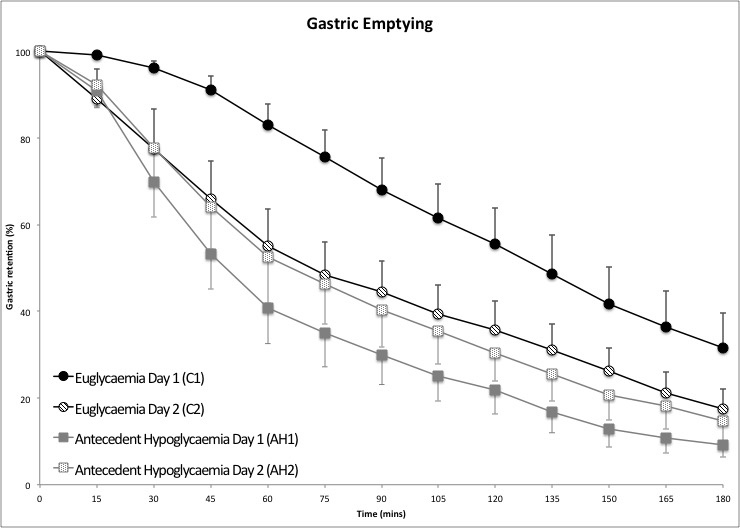Oral Presentation Australian Diabetes Society and the Australian Diabetes Educators Association Annual Scientific Meeting 2016
Effects of Antecedent Hypoglycaemia on the Gastric and Cardiac Responses to Subsequent Hypoglycaemia in Health (#81)
Introduction
In both health and patients with diabetes, acute hypoglycaemia triggers counter-regulatory responses accelerating gastric emptying and increasing cardiac contractility. However, antecedent hypoglycaemia attenuates endogenous catecholamine and vagal responses to subsequent hypoglycaemia (1). Our objective was to determine the effect of antecedent hypoglycaemia on gastric and cardiac responses to subsequent hypoglycaemia in health.
Methods
Ten healthy males were studied on two occasions, each lasting 30 hours, separated by ≥ 6 weeks and randomised to either:
- ‘Control’ (Day 1 (C1) - three blood glucose clamps at 6 mmol/L followed by day 2 (C2) - one hypoglycaemic clamp at 2.8 mmol/L), or
- ‘Antecedent hypoglycaemia’ (Day 1 (AH1) - three clamps at a blood glucose of 2.8 mmol/L followed by day 2 (AH2) - one clamp at 2.8 mmol/L).
Gastric emptying (GE) was measured on day 1 and 2, for both control (GEC1, GEC2) and antecedent hypoglycaemia (GEAH1, GEAH2) periods, using scintigraphy. Cardiac contractility was measured using fractional shortening (FS) via 2D echocardiography on days 1 and 2 of the control (FSC1, FSC2) and antecedent hypoglycaemia (FSAH1, FSAH2) periods. Data are mean (SE).
Results
Gastric emptying was faster (GEC2 AUC vs. GEC1 AUC, P=0.01) and fractional shortening greater (FSC2 vs. FSC1, P<0.01) during acute (single episode) hypoglycaemia compared to euglycaemia. Following antecedent hypoglycaemia, gastric emptying was unaffected (GEAH2AUC vs. GEC2 AUC, P=0.74, Figure 1) however fractional shortening may be reduced (FSAH2 vs. FSC2, P=0.06), although this was not statistically significant.
Conclusions
In health, the acceleration of gastric emptying during acute hypoglycaemia does not appear to be affected by antecedent hypoglycaemia whereas the increase in cardiac contractility may be attenuated.

- 1. Heller SR, Cryer PE. Reduced neuroendocrine and symptomatic responses to subsequent hypoglycemia after 1 episode of hypoglycemia in nondiabetic humans. Diabetes. 1991 Feb;40(2):223-6. PubMed PMID: 1991573.